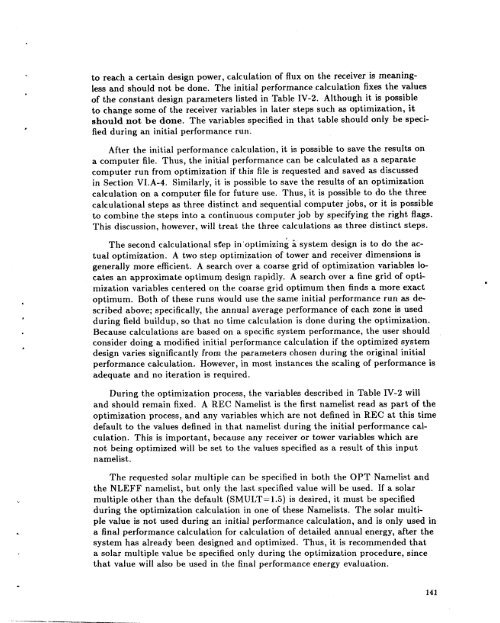A User's Manual for DELSOL3 - prod.sandia.gov - Sandia National ...
A User's Manual for DELSOL3 - prod.sandia.gov - Sandia National ...
A User's Manual for DELSOL3 - prod.sandia.gov - Sandia National ...
Create successful ePaper yourself
Turn your PDF publications into a flip-book with our unique Google optimized e-Paper software.
.I<br />
c<br />
to reach a certain design power, calculation of flux on the receiver is meaning-<br />
less and should not be done. The initial per<strong>for</strong>mance calculation fixes the values<br />
of the constant design parameters listed in Table IV-2. Although it is possible<br />
to change some of the receiver variables in later steps such as optimization, it<br />
should not be done. The variables specified in that table should only be speci-<br />
fied during an initial per<strong>for</strong>mance run.<br />
After the initial per<strong>for</strong>mance calculation, it is possible to save the results on<br />
a computer file. Thus, the initial per<strong>for</strong>mance can be calculated as a separate<br />
computer run from optimization if this file is requested and saved as discussed<br />
in Section V1.A-4. Similarly, it is possible to save the results of an optimization<br />
calculation on a computer file <strong>for</strong> future use. Thus, it is possible to do the three<br />
calculational steps as three distinct and sequential computer jobs, or it is possible<br />
to combine the steps into a continuous computer job by specifying the right flags.<br />
This discussion, however, will treat the three calculations as three distinct steps.<br />
The second calculational step in'dptimizing a system design is to do the ac-<br />
tual optimization. A two step optimization of tower and receiver dimensions is<br />
generally more efficient. A search over a coarse grid of optimization variables lo-<br />
cates an approximate optimuw design rapidly. A search over a fine grid of opti-<br />
mization variables centered on the coarse grid optimum then finds a more exact<br />
optimum. Both of these runs would use the same initial per<strong>for</strong>mance run its de-<br />
scribed above; specifically, the annual average per<strong>for</strong>mance of each zone is used<br />
during field buildup, so that no time calculation is done during the optimization.<br />
Because calculations are based on a specific system per<strong>for</strong>mance, the user should<br />
consider doing a modified initial per<strong>for</strong>mance calculation if the optimized system<br />
design varies significantly from the parameters chosen during the original initial<br />
per<strong>for</strong>mance calculation. However, in most instances the scaling of per<strong>for</strong>mance is<br />
adequate and no iteration is required.<br />
During the optimization process, the variables described in Table IV-2 will<br />
and should remain fixed. A REC Namelist is the first namelist read as part of the<br />
optimization process, and any variables which are not defined in REC at this time<br />
default to the values defined in that namelist during the initial per<strong>for</strong>mance cal-<br />
culation. This is important, because any receiver or tower variables which are<br />
not being optimized will be set to the values specified as a result of this input<br />
namelist.<br />
The requested solar multiple can be specified in both the OPT Namelist and<br />
the NLEFF namelist, but only the last specified value will be used. If a solar<br />
multiple other than the default (SMULT=l.5) is desired, it must be specified<br />
during the optimization calculation in one of these Namelists. The solar multi-<br />
ple value is not used during an initial per<strong>for</strong>mance calculation, and is only used in<br />
a final per<strong>for</strong>mance calculation <strong>for</strong> calculation of detailed annual energy, after the<br />
system has already been designed and optimized. Thus, it is recommended that<br />
a solar multiple value be specified only during the optimization procedure, since<br />
that value will also be used in the final per<strong>for</strong>mance energy evaluation.<br />
141<br />
a

















